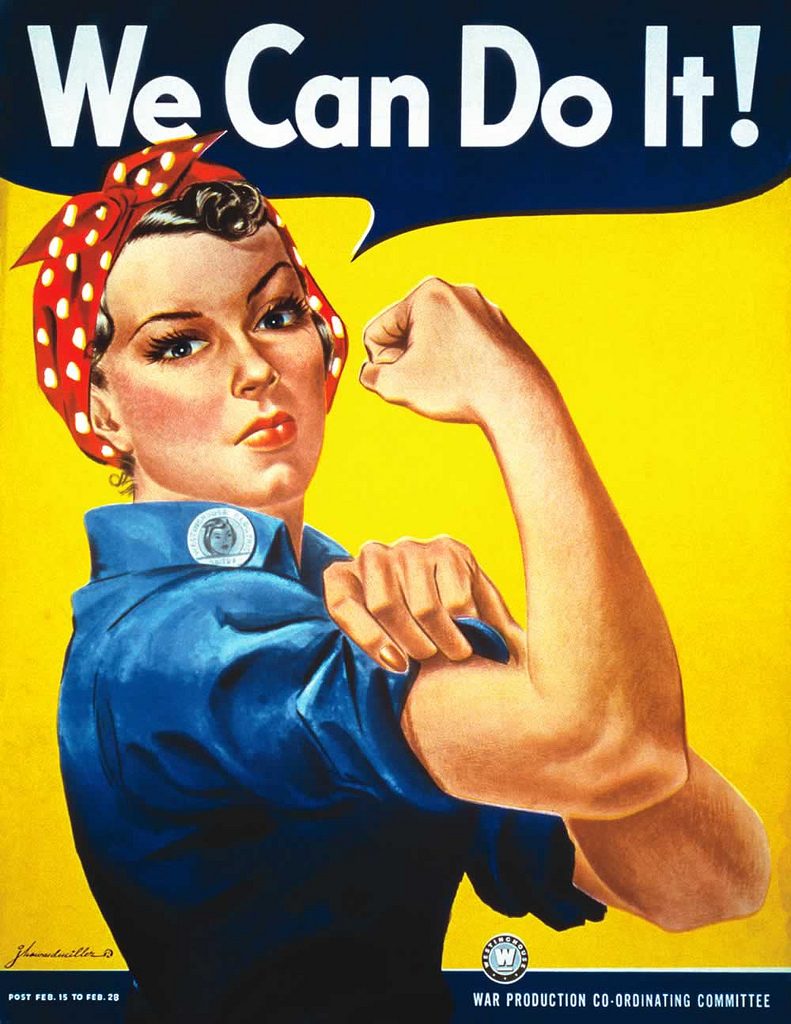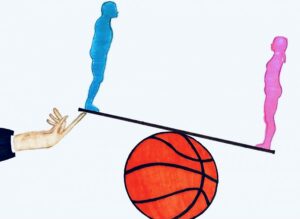From 1941 to 1945, during World War II, many woman were needed in the workplace because millions of men had joined the armed forces to fight in the European and the Pacific theaters of the war. In the Depression years just before this, women had been encouraged to stay at home, and let the men take the reduced number of manufacturing jobs available.1 With the onset of the war and the dramatically increased demand for manufactured wartime products, factories across the country opened their doors to women workers by the millions. In fact, there was a concerted effort to enlist women into the work force. In 1942, artist J. Howard Miller created the popular image of a woman named “Rosie the Riveter.” This poster was initially named, “We Can Do It!” and was made for the Westinghouse Electric and Manufacturing Company. Rosie was represented wearing makeup, a polka dot headband, and a rolled up sleeve shirt that portrayed strength and independence in women.2

Rosie the Riveter was a fictional character that many woman in the workforce identified with. The initial purpose of her image was to influence women to see themselves as capable of doing work previously thought to be men’s work. Her image combined beauty and strength, which is why many woman saw her as a role model. Even though Rosie the Riveter was a fictional character, her image was actually based on a photograph of a woman named Geraldine Doyle, who was a Michigan factory worker.3
There were some jobs that women took on that required training. Because of this, their wages were higher due to the fact that their jobs were more challenging and engaging compared to jobs that they may have had before. During the war, eighteen million women referred to themselves as being “Rosies.” Out of these eighteen million Rosies, six million had the opportunity to work for the first time. These women understood that the U.S. military and economy needed them; however, what motivated them to work was their own patriotism.4
In 1942, before Miller’s poster was created, Redd Evans and John Jacob Loeb wrote a song called, “Rosie the Riveter.” This hit song had lyrics that acknowledged and recognized the work that women did during the war:
All the day long whether rain or shine
She’s a part of the assembly line
She’s making history,
working for victory
Rosie the Riveter.
Keeps a sharp lookout for sabotage
Sitting up there on the fuselage
That little frail can do
more than a male will do
Rosie the Riveter.5
The song became associated with the existing images of Rosie the Riveter, which was a perfect blend of patriotism and beauty and strength in women.6
Unfortunately, after the war, the jobs and wages that Rosies had adapted to their lifestyles came to an end for the majority of them. Some went back to working “less challenging” jobs, and some became stay-at-home mothers. Because of this, birth rates increased, which led to the baby boom that lasted from 1946 through 1964. Even though many women went back to their previous lifestyles, they claimed to have left the workforce more confident and had more self-worth, knowing that they had proved to society that they were capable of doing men’s work.7
World War II changed the lifestyles of women significantly. Going from housewives to working in different industries allowed women to prove to society that this type of work was not just for men. There may have been no intention for women to prove themselves what they are capable of; however, women did leave their jobs after the war feeling better about themselves. Rosie the Riveter remains an iconic figure in American history, representing not only beauty in women, but also strength, courage, and confidence.
- Encyclopedia of Sex and Gender, 2007, s.v. “Rosie the Riveter,” by Susan L. Solomon. ↵
- America in the World, 1776 to the Present: A Supplement to the Dictionary of American History, 2016, s.v. “Rosie the Riveter,” by Nichola D. Gutgold. ↵
- Encyclopedia of Sex and Gender, 2007, s.v. “Rosie the Riveter,” by Susan L. Solomon. ↵
- Encyclopedia of Sex and Gender, 2007, s.v. “Rosie the Riveter,” by Susan L. Solomon. ↵
- Redd Evans and John Jacob Loeb, “Rosie the Riveter,” (New York: Paramount Music Corporation, 1942); The Four Vagabonds, “Rosie the Riveter,” recorded RCA Manufacturing Co., 1943. ↵
- America in the World, 1776 to the Present: A Supplement to the Dictionary of American History, 2016, s.v. “Rosie the Riveter,” by Nichola D. Gutgold. ↵
- Encyclopedia of Sex and Gender, 2007, s.v. “Rosie the Riveter,” by Susan L. Solomon. ↵



89 comments
Miranda Yzaguirre
Reading about women in the workforce is very inspiring. It is nice to think about how far women have progressed since the 40s; which really was not that long ago. It is still such a taboo for women to hold higher positions than men do. Rosie the Riveter is still an iconic symbol to this day. She inspires women to reach for whatever we could possibly want. One thing I did learn from this article is that Rosie was based off of a real woman, I always just thought she was made up for propaganda. The YouTube video was also a nice touch to keep readers engaged.
Amanda Figueroa
This is a well written and well descriptive article on a figure that encouraged many women. This gives the background as to why we admire this iconic poster so much and why she inspired women to do more. It’s disappointing reading how women had to step down from their jobs when the men came back from war, but this is what makes women realize they are just as strong and hard working.
Manuel Aguilera
As could be expected, I learned of Rosie the Riveter back in middle school and she was glossed over in high school, but she was not portrayed as well as she was in this article. I understood that Rosie was an iconic figure for women, but I did not know in what sense. I also learned that even after the endings of the wars, it had not occurred to me that women still retained the majority of the confidence that was bestowed upon them in the prior years. Also, I never actually knew that the fictional character was based off of an actual women, or at least the image was.
Jazmin Pizana
This article was absolutely great! I’ve seen the iconic picture of Rosie the Riveter many times before but never knew the history behind it. This picture had such a significant impact on women back then and to this day. She was such a huge influence and a beacon of hope that women were able to contribute more to society than just being stay-at-home housewives.
Mariet Loredo
Great article! I remember my junior year of high school during spirit week I dressed up as Rosie the Riveter. Rosie the Riveter is such a great role model to women because she shows the power a women has. She brought courage to women who might of had trouble showing it. Even though after the war most women went back to being housewives or they went back to their easy jobs, they knew that they were capable of much more than everyone thought.
Evelin Joseph
It was definitely great to read and learn more about the iconic Rosie the Riveter character through this article. It emphasizes just how much of an impact women had during World War II and their continuing importance in the world today. It is amazing that about eighteen million women were doing “men’s jobs” in the United States because of their ability and loyalty to the nation. It is distressing that these women were once again led to their previous lifestyles when the men came back, but it’s encouraging to know that they went back with feelings of self-worth and self-confidence.
Oceane Roux
Thank you for this article! I had seen the picture Rosie de Riveter before but never knew who she was and what was the context of this picture. Now that I know that it is related to the war, I assume this might be a part of the propaganda to bring everybody to work together during this period? In any case, it’s very important to show that women just as men can accomplish hard work and the article does a great job explaining it!
Michelle Falcon
I loved this article! Rosie the Riveter is an image that stands for women. It shows that not only are women beautiful but that they are also strong and independent. It’s amazing how one image can change the way of out daily lives. Although this image was released back during World War II, it has made a path for women still to come. Showing future women to go for their dreams and reinsure the fact that anyone, men and women alike, can do anything.
Amber Aragon Alvarado
This article articulates the fact that women are as equal as men. The image of Rosie impacted so many women and inspired them with confidence and security that they were just as good as any other man in a work place. Rosie became an icon and influenced many individuals to model what a woman truly consists of. I loved reading this article. It is such an inspiration to people today as discrimination still occurs in many areas. Rosie was a stepping stone towards the increase of courage in females back then and to this day. It was awesome reading about a picture I’ve seen in many classrooms, homes, restaurants, and offices. I finally understand the details of it and it honestly just inspires me to keep doing what I love doing–going to the gym being the best version of myself I could ever possibly be! Overall, amazing article to read. Enjoyed the song as well!
Andrea Chavez
The image itself of Rosie the Riveter was enough to get my attention. I really liked the way the information is presented in this article, it gives a great over view of what it represents and the why it was made. I really didn’t know that it was inspired in Geraldine Doyle. This makes me happy because it was inspired on a REAL woman. Meaning that women were already like that, without the need of a figure to inspire them.